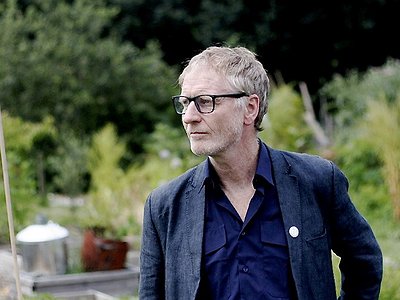Part 1
Name: Sean O'Hagan
Nationality: Irish
Occupation: Songwriter, producer
Current Release: "The Wild are Welcome" recorded by Sean O'Hagan with his daughter Livvy O'Hagan it out now and available here. His most recent solo album Radum Calls, Radum Calls is still available from Drag City.
Recommendations:
Music:
Woo - 1001 Decisions
1001 Decisions is that very thing, its sound and composition but beyond words. I can’t describe it.
Books:
Erin K. Parker - The Secret &The Sacred Collection of shorts stories. Erin lives in LA and her writing sometimes feels like a gentle breeze.
Magnus Mills - Screwtop Thompson.
This collection of short stories might remind you of Flann O’Brien, absurd gentle humour.
If you enjoyed this interview with Sean O'Hagan, you can find out more about him and his music on the website of his band The High Llamas or via his label Drag City.
When did you start writing/producing music - and what or who were your early passions and influences? What what is about music and/or sound that drew you to it?
I started to ‘write music’ in a conscious way just after meeting Cathal Coughlan in 1980, December 31st 1979 to be precise. We hit it off and, in what we thought was an oasis of newness in Cork City, we explored noise / poetry / and music reflecting the antxpop of The Fall, The Pop Group and Scritti Politti, who were still a little left of the mark in those days. Years later we realised that we were actually living in the heart of an essential folk music tradition which, as youths, we could not fully understand the unique beauty of.
Getting back to the music, it was not that sound that drew me in. It was more the act of creating organised sound with other people that gave me a sense of belonging. In those early days the music of John Cale, The Beach Boys, Miles Davies, Robert Wyatt and the (Les Disques du) Crépuscule and Ze Records labels, as well as Sheffield electronic music, was staple listening.
However it’s only as I grew older that I realised that the sound of Philly Soul and Motown, had a lasting effect on me, and that sound is the sound that I try to bring out in the form I produce now. I guess I heard that music every morning on Radio 1 as I headed out for school. The O’Jays, The Delfonics, Archie Bell, Marvin Gaye, Smokey Robinson. My mates were into Glam Rock, but the girls all loved the sound of early 70s soul.
When Cathal and I started fashioning music in the early iterations of Microdisney, all of this came into play and the whole knowledge process happened in the 10 years of that bands existence. I’m reminded of Cathal bringing Frankie Valli and the Four Seasons to the table at the same time as ‘Pet Sounds’.
For most artists, originality is first preceded by a phase of learning and, often, emulating others. What was this like for you? How would you describe your own development as an artist and the transition towards your own voice? What is the relationship between copying, learning and your own creativity?
Very important question. As early music makers, we are setting out to achieve the buzz we get as listeners from the sound we are trying to recreate. So we hear a life changing song and you are driven to the guitar or piano or 4-track machine, and we reach within to see if that buzz is within us.
So I think that process stays with us throughout our creative lives. However, the change that occurs which leads to the emergence of a singular voice, is almost undocumented. It happens in sleep and in pleasant stupors when our guard is down. I think we internalise new stuff without acknowledging the process and it emerges reformed, coloured and personalised.
When we first did this as 18-year olds, we absolutely wanted to nail the replication of that buzz sound. Later, the volume of consumed experience overwhelms us, so we are not so aware of the source, hence the veil of ownership descends.
What were your main compositional- and production-challenges in the beginning and how have they changed over time?
As a young man, I think I was listening to every sound and wondering how it might be achieved. At the outset, it was a different world. Cathal and I were creative drivers, but we worked with producers. It was old school. In rehearsals prior to producers arriving, we were very much directing sound with three other players in the room. Playing reference tracks, demonstrating the part on instruments.
When the producers arrived we were inspired but also slightly insecure about what might be lost from those precious 4-track demos. I think we are well-listened and probably had an accumulative knowledge, a landscape of music that even a producer might find daunting. These guys were allies and did know how that sound was achievable. Old school. Instrument doubling, harmonizing, corridor reverbing, plate setting and BV layering in the old school way.
Later, as a producer either in the studio in the 90s working on tape and fidgeting with early tech to ‘fly in parts from Ataris, or later in the home studio editing in Logic Pro X, I follow/followed a very deep, almost spiritual, drive to verbalise the sound I’m trying to achieve. It’s literally a sleep-stopping time-losing state of quandary that can last quite a while. It might be a key change or a drum sound or a search for a sub sound that puts the track in the right space. That’s the challenge. It’s an unworried search that can be forever but could happen in a tumbling of events over an hour.
I still listen to a lot of odd Gospel, odd soul, Valentino’s, Womack, Sly Stone, Laura Nyro, Impressions … And that is to root whatever I’m working on, whether it is a Brazilian-driven chant, or a small electronic pop track, or a Vashti Bunyan-orchestral folk song. The intention and resource of that 60s/70s soul sound reminds me always of how things in this track can be better. It always works.
What was your first studio like? How and for what reasons has your set-up evolved over the years and what are currently some of the most important pieces of gear for you?
I started out as a producer with a pre-G3 Mac running Logic 3 through the hold Pro Tools digi design 8 converters. I used a lot of Reactor Instruments (Native Instruments) and early granulator plug-ins.
I always have pretty cruddy outboard, SPX90 reverbs, TL Audio compressor. But a Neve 9098 pre-amp pretty much saves everything. Now I run Logic 10.3 on an iMac I’ve had from 2009, with an SSD D drive. The machine is solid, so I’m not changing yet.
I use an Apogee Ensemble converter and Adam AX 7 monitors alongside Genelec 1029s.
I still use vintage stuff, Wurlitzer piano and a Vox Continual organ, Korg CX3, Elka mono synth, Rogue Moog, Realistic Moog, Juno 6, ATC Chameleon, CR78 and a SOUNDTECH Rhythm Box.
When I’m at home, my mics are sad. Rode K2 condenser, AT 330, AKG 300 Pair, Okava, MK2 19. But so much is recorded at Press Play Studios run by Andy Ramsay, and his mic collection is superb, as well as running a beautiful Neve 5038. I usually borrow a Neumann 67, or a Sony C100.
But you know it’s never about the mic or the gear. It’s always about the idea and the space. I’m happy to delve into the UA Satellite and exploit it’s outboard power or use Valhalla reverbs or Soundtoys if I can get the idea down quickly and the idea is good.
How do you make use of technology? In terms of the feedback mechanism between technology and creativity, what do humans excel at, what do machines excel at?
Ok. Human beings excel at changing the narrative in the music history and technology responds to the human narrative. Great kit does try to think a step ahead and try to pre-empt the working patterns of makers, setting up pathways and preset drop down menus. Technology makers often assume a practice. For instance, you record drums first, there is always a bass, etc. it also assumes you want perfect time. All of this is choice but the user must set up the pathway that does not allow the tech to take control.
Production tools, from instruments to complex software environments, contribute to the compositional process. How does this manifest itself in your work? Can you describe the co-authorship between yourself and your tools?
Yes. I love to use ring modulation on so much stuff. I love the recorded movement of ring mods on keys to drum machines to acoustic nylon string guitars and pianos. The moving mod will create melodic overtones, which are unknowable, so it will surprise a producer.
I know there is an older reactionary abhorrence of pitch correction on vocals, but I love that super sweet ramp through a bit crushed throwaway. It very much belongs to the generation and I totally love it. It has soul. No joke.







